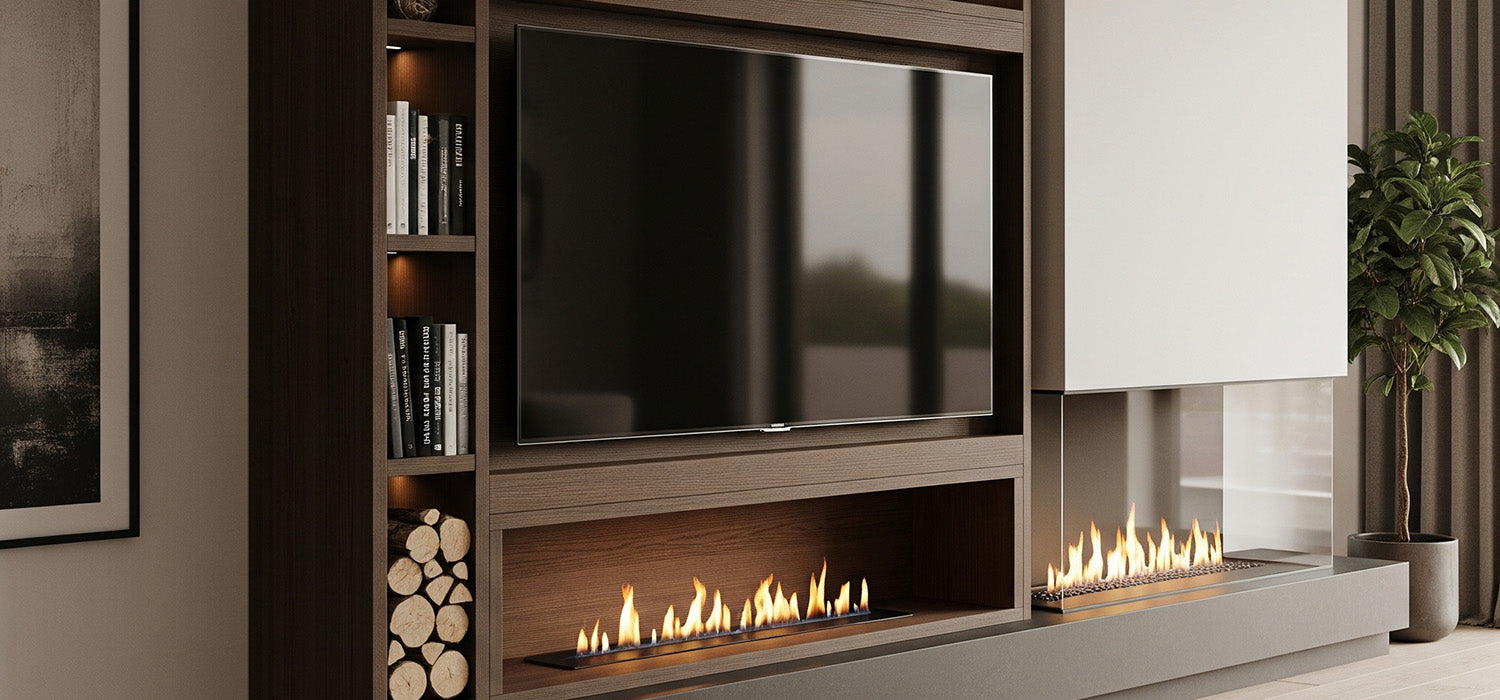
How to Build a Media Wall Over Carpet Safely and Securely
Got carpet? No problem. You can build a media wall on it—yes, even with a media wall fire—without turning your floor into a wobbly jelly. The trick? Smart base prep, fire-safe fixes, and renter-friendly hacks. Stick around to keep things stable, stylish, and scorch-free.
Carpet vs Media Walls: The Hidden Challenge
Most homes across the UK still have carpeted living rooms. It’s soft underfoot, warm in winter, and great for noise control. But when it comes to building something weighty like a media wall, carpet isn’t exactly your best mate.
Imagine trying to balance a tall bookshelf on a mattress. That’s what happens when you put a frame-heavy wall on thick carpet with squishy underlay. Without proper prep, your setup could end up unstable, tilted—or worse—unsafe.
How Carpet Affects Media Wall Stability
The Problem with Plush Underlay
If you’ve got thick underlay, you’ll likely notice some movement the second you start placing weight on your media wall. It may look fine at first, but over time, you could see slight leaning, sagging or that telltale creak of shifting MDF.
Now imagine that with a 60-inch telly on it.
Weight Distribution Woes
Heavy components like electric fires, soundbars or built-in shelves all add to the strain. Spread across an uneven carpet base, the load becomes concentrated in spots, leading to compression. It’s like footprints in fresh snow—but permanent.
That’s why pros often use platforms or base boards to even things out.
How to Keep Your Media Wall Rock Solid on Carpet
Build a Raised Platform Base
Think of it as a mini stage for your wall. A raised base made from 2x4 timber and topped with plywood gives your frame something solid to sit on. It’s especially handy for floating designs or when you’re avoiding damage to rented floors.
And because you’re not fixing it to the floor, it can be moved, upgraded, or adapted later.
Using MDF or OSB Boards as a Base Layer
Not into building a full frame? No worries. You can lay flat sheets of MDF or OSB across the carpeted section before you start your wall frame.
This trick works wonders to even out pressure and avoid carpet dents, especially with thinner or budget carpets. It’s a simple step that makes everything feel far more secure—and looks cleaner too.
Should You Cut the Carpet Underneath?
If you’re going permanent, yes, you can. Many joiners recommend trimming back the carpet under the media wall footprint and rolling it back neatly. You’ll then be able to attach your frame to the subfloor, giving ultimate stability.
Best part? If you ever decide to remove it, that piece of carpet can often be relaid—or replaced with an offcut.
Keeping Things Safe: Fires and Carpet Don’t Mix
Play It Smart with Electric Fires
If your media wall includes a built-in electric fire, fire safety becomes critical. Always place a fire-rated board beneath and behind the unit, even if the carpet doesn’t touch the appliance directly.
Open-flame or bioethanol fires? Give them a wide berth on carpeted floors—no exceptions. Too risky.
Airflow and Clearance Matter
Make sure your fire unit has room to breathe. Carpet can restrict ventilation at the base, so check the manufacturer’s recommendations. And don’t skip trims or barriers—they stop the carpet from fraying or catching heat.
Smart Finishing Touches to Blend with Carpet
A media wall should feel like part of the room, not a bulky bolt-on. If you're building over carpet, how you finish the base matters.
Add Skirting or a Flush Toe-Kick
You can use MDF skirting at the base to blend the wall into the room’s original trim, or install a flush board that gives a clean, contemporary finish. Match the colour to your wall or carpet for a seamless look.
It’s a small touch, but it makes a huge difference visually.
Clever Cable Management (Even with Carpet)
Nobody wants a cable snake pit behind the telly. On hard floors, cable covers are easy to install—but what about carpet?
Use Flat Cable Trunking or Concealed Channels
Low-profile trunking along the back of the wall or inside your frame keeps everything neat and trip-free. Adhesive trunking can be stuck directly to the wall without screws—ideal for renters.
And if you’re going built-in, you can run cables through the frame itself, out of sight and safely away from heat.
What If You’re Renting? Here’s Your Move
Building over carpet in a rented home might feel like a no-go—but it doesn’t have to be.
Go Freestanding and Skip the Drill
Design a freestanding media wall that sits flush against the wall, but doesn’t require drilling or cutting carpet. Use tension brackets to keep it steady, and lay a protective board beneath to avoid indentations.
Bonus: when it’s time to move out, just lift and go. Your landlord won’t even notice.
Keeping Your Carpet Looking Good
Even with the best setup, carpet can suffer wear over time.
Vacuum around the base regularly, and if the carpet does dent, a steamer or carpet brush can help revive it. Still worried? Slip some hard plastic sliders or carpet protectors underneath key pressure points.
Final Word: Yes, You Can Build on Carpet
Let’s settle it—carpet isn’t the enemy of great design. With a few smart adjustments, your dream media wall can sit right on top of it and look like it’s built into the room.
From raised bases to floating trims, cable hides to fire safety tips, you’re all set. Whether you rent or own, you’ve got options that keep things secure and stylish—no need to rip up your favourite flooring.
So grab the toolkit, pick your layout, and make your media wall the star of the room. Carpet and all.
Other content we think you'll love
- Bedroom Media Wall Ideas: Create a Stylish & Cosy Retreat
- Corner Media Wall Ideas: Smart Design for Tricky Spaces
- Black Media Wall Ideas for Bold & Stylish Living Spaces
- How to Build a Media Wall Backboard for a Sleek TV Setup
- Media Wall Cladding: Add Texture, Style and Wow Factor
- Media Wall Covering: Stylish Finishes to Elevate Your Space
- Media Wall Construction: How to Build the Ultimate Feature Wall

